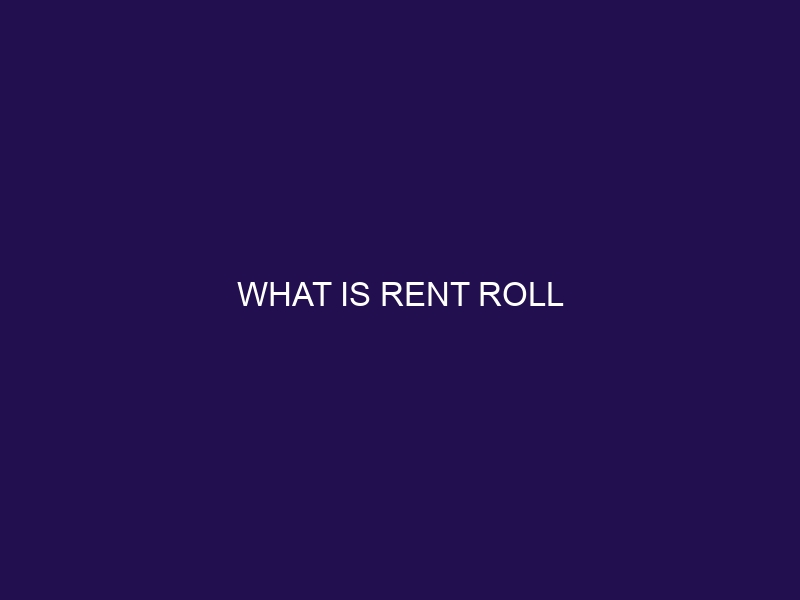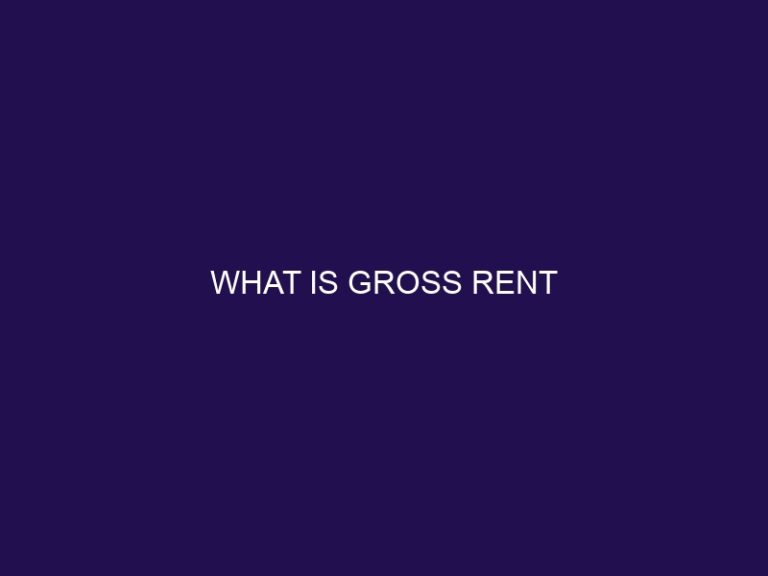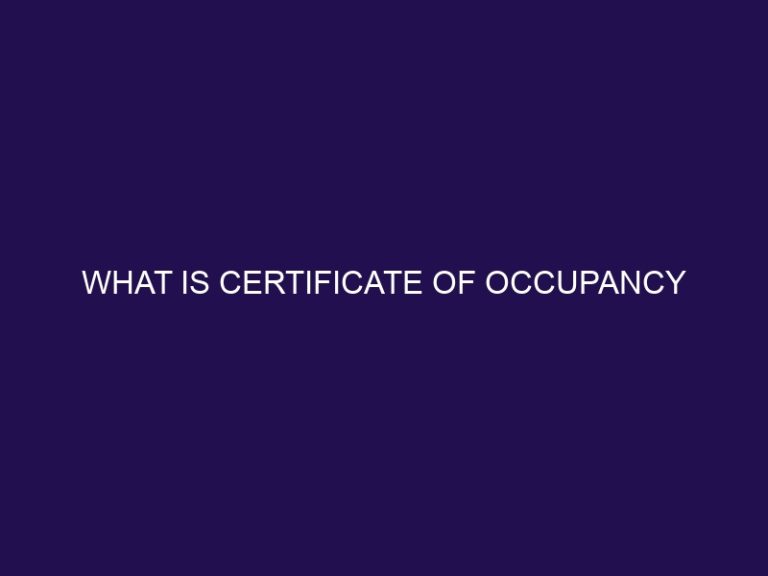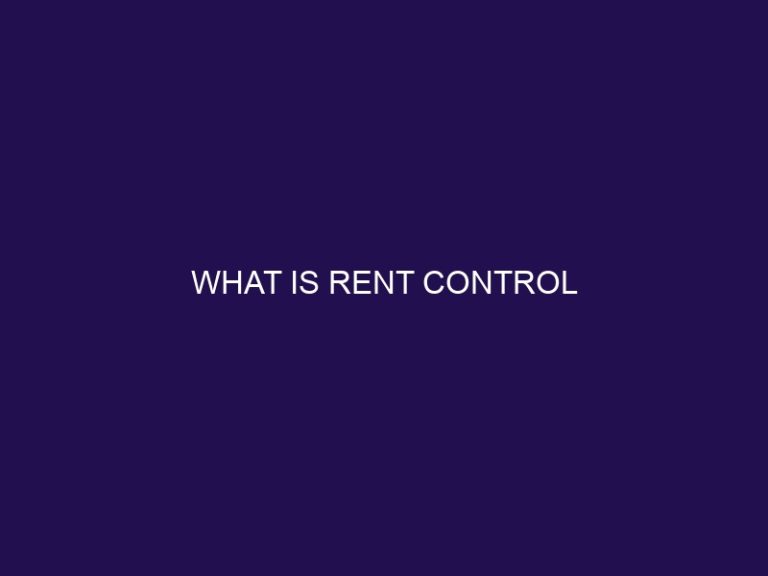What is Rent Roll
Rent roll is an essential concept in the real estate industry that plays a significant role in property management and financial analysis. It provides crucial information about the rental income and tenant details of a property. Understanding rent roll is vital for property owners, landlords, and investors to effectively manage their real estate investments.
Rent roll refers to a comprehensive document that outlines the rental information of a property. It includes details such as tenant names, rental rates, lease terms, and total rental income. It serves as a central database for property owners to track and manage their rental properties.
A well-maintained rent roll is important for several reasons. Firstly, it provides valuable insights into the financial health of a property by allowing property owners to analyze rental income and forecast future cash flows. Secondly, the rent roll assists in property valuation by providing essential rental data that is considered when determining the market value of a property.
The rent roll facilitates tenant management by providing a centralized platform to track tenant details, lease expiration dates, and rental history. This ensures efficient communication and streamlines property management processes.
Creating and maintaining a rent roll involves gathering accurate data, organizing the information in a structured manner, and regularly updating the rent roll with any changes to tenant details or rental rates. Effective management of a rent roll is essential to ensure accurate financial reporting and smooth property operations.
However, managing a rent roll can present challenges, such as dealing with delinquent tenants, handling lease renewals, and coping with fluctuating rental market conditions. Overcoming these challenges requires effective communication, proactive tenant management strategies, and staying updated on market trends.
What is Rent Roll?
Rent roll is a crucial aspect of the real estate industry that plays a pivotal role in property management and financial evaluation. In this section, we’ll pull back the curtain on the mysterious world of rent roll and uncover its true meaning. We’ll delve into the definition of rent roll, shedding light on its significance and implications within the realm of property ownership and investment. Get ready to unravel the secrets behind this fundamental element of the rental market.
Definition of Rent Roll
A rent roll is a crucial tool in real estate management to track rental income and tenant information. It provides detailed data for property valuation, financial analysis, and tenant management. The rent roll, which can be defined as a comprehensive document, includes information such as tenant details, rental rates, lease terms, and rental income. Creating and maintaining a rent roll involves gathering data, organizing information, and regular updates. Managing a rent roll can come with challenges, including recurring issues, safety concerns, and costly maintenance. In essence, a rent roll, as defined by its purpose, helps landlords and property managers effectively manage their rental properties.
True story: I had a friend who owned multiple rental properties, and keeping track of the rental income and tenant details became overwhelming. Once they implemented a rent roll system, which aligned with the definition of a rent roll, it made their life much easier, allowing them to quickly access important information and streamline their management processes.
Why is Rent Roll Important?
Discover the significance of rent roll and why it plays a crucial role in the world of real estate. Uncover the benefits that come with closely monitoring and managing rent roll, and gain insights into the pivotal role it plays in the overall functioning of the real estate industry. Whether you’re a landlord or a property investor, understanding the importance of rent roll will pave the way for informed decision-making and maximizing your investment potential. Let’s dive into the world of rent roll and unlock its essential role in real estate.
Benefits of Rent Roll
Rent roll offers a range of benefits to property owners and managers, making it an indispensable tool in the field of real estate management.
- Efficient Tracking: Rent roll provides a comprehensive snapshot of all rental properties, tenants, lease terms, and rental income, resulting in easy organization and tracking of important information.
- Financial Analysis: By analyzing rent roll data, property owners can gain valuable insights into the financial performance of their properties, empowering them to make well-informed investment decisions.
- Tenant Management: Rent roll assists in managing tenant information such as contact details, rental rates, and lease terms, facilitating effective communication and efficient lease administration.
- Property Valuation: Accurate rent roll data plays a critical role in determining the value of a property, imparting valuable information to potential investors or lenders.
- Strategic Planning: Rent roll analysis enables property owners to identify trends and patterns, empowering them to develop strategies that optimize rental income and minimize vacancies.
Role of Rent Roll in Real Estate
The role of the rent roll in the real estate industry is undeniably crucial. It functions as an indispensable source of information for property management, encompassing tenant details, rental rates, lease terms, and rental income. This extensive data holds immense importance in property valuation, financial analysis, and tenant management. Additionally, the rent roll proves to be invaluable in aiding investors and property owners in comprehending the financial performance of their assets, thus enabling them to make well-informed decisions. Furthermore, it serves as a tool for recognizing recurring issues, safety concerns, and expensive maintenance. Ultimately, the rent roll significantly contributes to maximizing the efficiency and profitability of real estate investments.
What Information is Included in a Rent Roll?
Curious about rent rolls? Diving into the information included in a rent roll, we’ll explore tenant details, rental rates, lease terms, and rental income. Get ready to discover the valuable insights and key figures that make up this essential document for property management. Unveiling the data behind each aspect, we’ll paint a vivid picture of what goes into a comprehensive rent roll. Stay tuned for an enlightening journey into the world of rental property dynamics!
Tenant Details
In a rent roll, tenant details provide essential information about the occupants of a property. Tenant details refer to the tenant’s name, contact details, unit or property information, lease start and end dates, and rent amount. Keeping accurate tenant details is crucial for effective property management and tenant communication. It helps landlords stay organized, track leases, and collect rent on time. Tenant details can be used for legal purposes, such as preparing lease agreements and resolving disputes. Regularly updating tenant information ensures that landlords have the most up-to-date and accurate records.
To streamline tenant details and automate rent collection and lease tracking processes, it is recommended to use property management software. This software can help in regularly reviewing and verifying tenant information, which is important to ensure accuracy and compliance with data protection regulations.
Rental Rates
Rental rates play a crucial role in the management of a rent roll. Here is a table showcasing the importance of rental rates:
| Importance of Rental Rates | |
|---|---|
| Accurate Pricing | Properly set rental rates ensure that properties are priced competitively, attracting tenants and maximizing rental income. |
| Market Analysis | Regularly reviewing rental rates helps property managers stay informed about market trends and make adjustments accordingly. |
| Tenant Retention | Reasonable rental rates contribute to tenant satisfaction and increase the likelihood of lease renewals, reducing vacancy rates. |
| ROI Calculation | Accurate rental rates allow property owners to calculate the return on investment, helping them make informed financial decisions. |
Rental rates are a crucial factor in the success of property management. By understanding market trends and setting competitive rates, property owners can maximize their rental income while maintaining tenant satisfaction.
In the 1980s, the introduction of rental market deregulation led to an increase in rental rates across many cities. This historical shift highlighted the importance of rental rates in the real estate industry.
Lease Terms
Lease terms are a critical element of a rent roll, providing essential information about the agreements between landlords and tenants. When it comes to lease terms, here are some key aspects to consider:
- Lease Duration: This specifies the length of time the tenant is allowed to occupy the property, typically ranging from months to years.
- Rent Amount: The lease terms should clearly state the agreed-upon rent amount, including any additional charges or fees.
- Payment Schedule: The lease terms provide details regarding when and how the rent should be paid, whether it’s through monthly or quarterly payments.
- Renewal and Termination: The lease terms outline the conditions for renewing or terminating the lease, including notice periods and any associated penalties or fees.
- Property Use: Restrictions on how the tenant can use the property, such as subleasing or running a business from the premises, may be included in the lease terms.
- Repairs and Maintenance: The responsibilities for repairs and maintenance, including who is accountable for specific areas or appliances, must be clearly outlined in the lease terms.
Rental Income
The rental income is a crucial aspect of the rent roll, which helps property owners and managers track the financial performance of their rental properties. It includes the revenue generated from the rental units within a specific timeframe. The rental income column in a rent roll table typically displays the monthly or annual rent amount for each tenant. It allows property owners to calculate their total rental income and analyze cash flow, profitability, and overall investment returns. Rental income figures are vital for performing financial analysis, determining property valuations, and making informed decisions regarding rent adjustments and lease renewals. The rental income column helps property managers stay organized and monitor the financial health of their rental portfolio.
How is Rent Roll Used?
Discover how the concept of rent roll is applied in practical scenarios. In this section, we explore how rent roll is utilized in various aspects such as property valuation, financial analysis, and tenant management. Uncover the ways in which rent roll serves as a valuable tool in understanding the financial performance and management of rental properties. Delve into the strategies and insights that can be derived from analyzing rent roll data to make informed decisions in the real estate industry.
Property Valuation
Property valuation is a critical aspect of managing a rent roll. It involves determining the current market value of a property based on various factors such as location, size, condition, and rental income. Accurately valuing a property helps landlords and investors make well-informed decisions about buying or selling properties. A rent roll provides valuable information on rental income, lease terms, and tenant details, which are essential in assessing the value of a property. By analyzing the rent roll data, landlords can evaluate the investment potential and profitability of their properties and make strategic decisions regarding rent adjustments and property improvements.
Financial Analysis
A thorough financial analysis is an essential aspect of managing a rent roll. It helps property owners evaluate the profitability and performance of their rental properties. Here is a table summarizing the key components of the financial analysis:
| Components | Importance |
|---|---|
| Cash Flow Analysis | Determines the net income generated by the rent roll after deducting expenses. |
| Return on Investment (ROI) | Measures the profitability of the rental properties and aids in comparing different investment opportunities. |
| Occupancy Rates | Reflects the number of occupied units and is a key factor in determining the stability and potential revenue of the rent roll. |
| Operating Expenses | Includes costs such as maintenance, repairs, property management fees, and insurance. Evaluating these expenses ensures accurate financial planning. |
| Debt Service Coverage Ratio (DSCR) | Measures the ability of the rent roll’s income to cover its debt obligations. It is essential for evaluating the property’s financial health and obtaining financing. |
A comprehensive financial analysis enables property owners to make informed decisions regarding rental rates, expenses, and potential improvements to maximize their return on investment.
Tenant Management
Tenant management is an essential aspect of maintaining a successful rent roll. Here are some key considerations for effective tenant management:
- Communication: Establish clear lines of communication with tenants to address their concerns and promptly respond to any maintenance issues.
- Lease Enforcement: Ensure that tenants comply with the terms of their lease agreements, including rent payments and property upkeep.
- Tenant Retention: Foster positive relationships with tenants by providing excellent customer service and meeting their needs, leading to increased tenant satisfaction and longer lease terms.
- Document Organization: Keep detailed records of tenants, lease agreements, and communication, facilitating the tracking of rental history and the resolution of any disputes that may arise.
Pro-tip: Regularly assess the condition of your rental properties and implement preventative maintenance measures to minimize tenant turnover and enhance overall satisfaction.
How to Create and Maintain a Rent Roll?
Confused about creating and maintaining a rent roll? Don’t worry, we’ve got you covered! In this section, we’ll walk you through the process step by step. From gathering data to organizing information and providing regular updates, we’ll equip you with all the essential know-how to ensure a seamless rent roll management. So, let’s dive in and uncover the secrets to effectively create and maintain a rent roll, all backed by reliable sources and industry insights!
Gathering Data
Gathering data for a rent roll involves collecting and organizing crucial information about tenants, rental rates, lease terms, and rental income. This data is essential for property valuation, financial analysis, and tenant management. To create and maintain an accurate rent roll, follow these steps:
- Gather tenant details such as names, contact information, and lease start and end dates.
- Record rental rates for each unit, including any variations.
- Document lease terms, such as length and any special conditions.
- Track rental income, including any additional charges or late fees.
Regularly updating the rent roll ensures accurate and up-to-date information for effective property management.
| Tenant Details | Rental Rates | Lease Terms | Rental Income |
| John Smith | $1,200/month | 1-year lease | $14,400/year |
| Jane Doe | $1,500/month | 6-month lease | $9,000/year |
Organizing Information
To efficiently organize information in a rent roll, follow these steps:
1. Begin by gathering all the essential data, including tenant details, rental rates, lease terms, and rental income.
2. Utilize either a spreadsheet or specialized software to arrange the information in a clear and structured manner.
3. Ensure that you regularly update the rent roll to maintain the latest tenant and financial information.
4. Categorize the information by properties or units, as this will facilitate tracking and analyzing data.
5. Implement a consistent naming or numbering system to easily identify and locate specific information.
6. Additionally, consider incorporating extra fields or columns, such as lease start and end dates, payment history, and tenant contact information. This will further streamline organization and management.
Regular Updates
Regular updates are crucial for maintaining an accurate and up-to-date rent roll. Here are some key reasons why regular updates are important:
- Ensure accuracy: Regular updates help ensure that all tenant details, rental rates, lease terms, and rental income are accurately reflected in the rent roll.
- Track changes: By regularly updating the rent roll, property managers can track any changes in tenant occupancy, lease renewals, or rental rate adjustments.
- Inform decision-making: Updated rent rolls provide reliable data for property valuation, financial analysis, and tenant management decisions.
- Compliance and record-keeping: Regular updates aid in maintaining compliance with legal and regulatory requirements and provide a comprehensive record of the property’s rental history.
Common Challenges in Managing Rent Roll
Managing a rent roll can be a complex endeavor filled with numerous challenges. From recurring issues to safety concerns and costly maintenance, this section will dive into the common obstacles faced by property managers. Get ready to uncover the real-world experiences, facts, and figures that shed light on the demanding nature of rent roll management. So buckle up and prepare to navigate through the rollercoaster of challenges that come along with this crucial aspect of property management.
Recurring Issues
Managing rent rolls can come with a multitude of recurring issues that property owners and managers must address. These recurring challenges can significantly impact the smooth operation and profitability of rental properties.
- Dealing with delayed rent payments: Managing tenants who consistently make late payments or fail to pay their rent on time can disrupt cash flow and create financial strain.
- Addressing tenant complaints: Promptly handling recurring tenant complaints, such as maintenance issues or disputes with neighbors, is essential to maintain tenant satisfaction.
- Struggling with tenant turnover: Continuously searching for new tenants due to high turnover rates can be both costly and time-consuming for property owners.
- Maintenance and repairs: Regularly maintaining and repairing rental properties can pose as an ongoing challenge, particularly when faced with aging infrastructure, plumbing issues, or electrical problems.
The Leaning Tower of Pisa is a historic site renowned for its recurring issue of architectural instability. Due to a poor foundation and soft soil, the tower started to tilt shortly after construction began in 1173. Engineers and conservationists have made numerous attempts over the centuries to stabilize and correct the lean, resulting in an ongoing challenge.
Safety Issues
Safety issues are a critical concern when it comes to managing a rent roll in the real estate industry. The well-being of tenants is of utmost importance, and it is essential for landlords to promptly address any potential hazards. This involves performing regular inspections, ensuring the implementation of proper fire safety measures, and attending to maintenance issues that could jeopardize safety. By taking a proactive approach to addressing safety concerns, landlords can establish a secure living environment for their tenants and reduce the likelihood of accidents or injuries. Here’s an interesting fact: The National Fire Protection Association reveals that cooking equipment is the primary cause of home fires and home fire injuries.
Costly Maintenance
Costly maintenance is a critical aspect of managing a rent roll in real estate. It can significantly impact the profitability and success of the property. Here are some common challenges related to costly maintenance:
- Recurring issues: Properties may experience recurring maintenance problems, such as plumbing issues or HVAC system failures, which can result in high repair costs.
- Safety issues: Neglecting maintenance can lead to safety hazards, putting tenants at risk and potentially resulting in costly legal liabilities.
- Costly maintenance: Conducting regular maintenance, repairs, and upgrades can be expensive, reducing overall profitability.
To address these challenges, it is crucial to prioritize preventive maintenance, conduct regular inspections, and establish a budget for maintenance expenses. Implementing long-term maintenance plans can help minimize costly repairs and ensure the property’s value is preserved.
Frequently Asked Questions
What is a rent roll?
A rent roll is a management tool used in real estate that provides detailed information about properties, including lease information, rental income, and contract dates. It helps landlords track and manage their properties and can also aid in predicting the profitability of investments.
How does a rent roll work?
A rent roll works by collecting and organizing vital property information, such as unit details, tenant information, rental income, and lease terms. This information can be used to review data, assess the financial performance of a rental property, and make informed decisions to improve property performance.
Why is a rent roll important for rental property investors?
A rent roll is essential for rental property investors as it provides a quick snapshot of a property’s current profitability and potential future profitability. By analyzing the rent roll, investors can determine the income stream, assess the element of risk, and make informed decisions regarding future sales or investments.
How can a rent roll benefit real estate companies and building owners/overseers?
A rent roll benefits real estate companies and building owners/overseers by providing a comprehensive and itemized report of each unit in a portfolio. This allows them to maximize gross rental income, review data for multiple properties, and make strategic decisions to improve overall property performance.
What information is included in a rent roll?
A rent roll typically includes vital information such as property details (address, square footage, amenities), tenant details (lease agreements, rent payment history, security deposits), and rental income summary (total monthly and annual rent collected, additional income or fees).
How can a rent roll be used during real estate transactions?
During real estate transactions, a rent roll is used in the due diligence process to assess the financial stability and potential of an income-producing property. Interested real estate buyers can review the rent roll to determine the true value of the property, future sales or rental income potential, and evaluate the associated risks.







